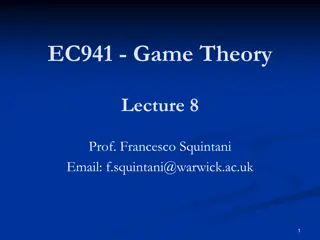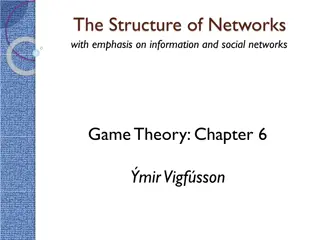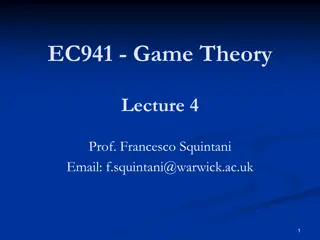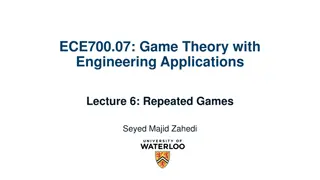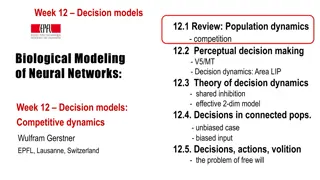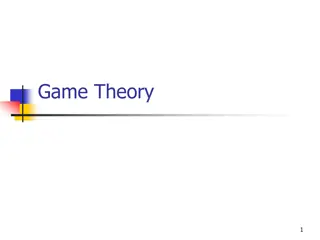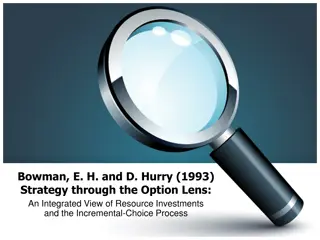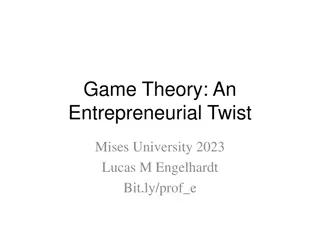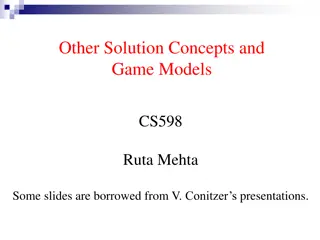Understanding Game Theory: A Strategic Framework for Decision Making
Game theory is a theoretical framework that analyzes social situations involving competing players. It helps predict outcomes in scenarios like pricing competition and product releases. Key elements include players, payoff, strategies, and optimal decisions. Game theory involves various types of games such as two-person games, zero-sum games, pure strategy games, and mixed strategy games.
Download Presentation

Please find below an Image/Link to download the presentation.
The content on the website is provided AS IS for your information and personal use only. It may not be sold, licensed, or shared on other websites without obtaining consent from the author. Download presentation by click this link. If you encounter any issues during the download, it is possible that the publisher has removed the file from their server.
E N D
Presentation Transcript
GAME GAMETHEORY THEORY
Game Theory : Game Theory : Game theory is a theoretical framework of conceiving social situations among competing players. In some respects, game theory is the science of strategy, or at least the optimal decision making of independent and competing actors in a strategic setting. Using game theory , real world scenarios for such situations as pricing competition and product releases can be laid out and their outcomes predicted. Scenarios include the prisoner s dilemma and the dictator game among many others.
Classification Classificationof Game of Game Two Two- -Person Game Person Game - A game with 2 number of players. Zero Zero- -Person Sum Game Person Sum Game A game in which sum of amounts won by all winners is equal to sum of amounts lost by all losers. Non Non- -Zero Sum Game Zero Sum Game A game in which the sum of gains and losses are not equal. Pure Pure- -Strategy Game Strategy Game A game in which the best strategy for each player is to play one strategy through out the game. Mixed Strategy Game Mixed Strategy Game A game in which each player employs different strategies at different times in the game.
Key Elements in game theory Key Elements in game theory Player Player : A strategic decision maker within the context of the game is called the player in the game theory. Pay Off Pay Off : The outcome of the game resulting from a particular decision is called pay off. It is assumed that pay off is also known to the player in advance. It is expressed in times of numerical values such as money, percent of market share or utility. Pay Off Matrix Pay Off Matrix : The pay offs in terms of gains or losses when players select their particular strategies can be represented in the form of matrix is called pay off matrix. Strategy Strategy: The strategy for a player is the list of all possible actions that he will take for every pay-off that might arise. It is assumed that all course of possible actions are known to the player.
Optimal Strategy Optimal Strategy : The particular strategy by which a player optimizes his gains or losses without knowing the competitor s strategies is called optimal strategy. Value of the Game Value of the Game : The expected outcome when players follow their optimal strategy is called the value of the game. It is denoted by v. Types of Strategy Types of Strategy Usually player in game theory uses two types of strategy namely pure strategy and mixed strategy Pure Strategy Pure Strategy : Particular course of action that are selected by player is called pure strategy i.e. each player knows in advance of all strategies out of which he always selects only one particular strategy regardless of the other players strategy. Mixed Strategy Mixed Strategy : Course of action that are to be selected on a particular occasion with some fixed probability are called mixed strategies i.e. there is a probabilistic situation by making choice among pure strategy with fixed probabilities.
Basic Assumptions of Game Basic Assumptions of Game Each player has available to him a finite number of possible strategies. The list may not be the same for each player. Player A attempts to maximise gains and player B minimize losses. The decisions of both players are made individually prior to the play with no communication between them. The decisions are made simultaneously and also announced simultaneously so that neither player has an advantage resulting from direct knowledge of the other player s decision. Both the players know not only possible pay offs to themselves but also other.
Minmax Minmax- -Maxmin MaxminPrinciple Principle The selection of an optimal strategy by each player without the knowledge of the competitor s strategy is the basic problem of playing games. The objective of the study is to know how these players select their respective strategy so that they may optimize their payoff. Such a decision making criterion is referred as to the minmax- maxmin principle. Saddle Point Saddle Point If the minmax value = maxmin value, then the game is said to have a saddle (equilibrium) point.
Procedure to determine Saddle Point Select the minimum element in each row of the pay off matrix and write them under row minima heading. Then select the largest element among these elements and enclose it in a rectangle. Select the maximum element in each column of the pay matrix and write them under the column maxima heading. Then select the lowest element among these elements and enclose it in a circle. Find out elements which is same in the circle as well as rectangle and mark the position of such elements on the matrix. This element represents the value of the game and is called saddle point.
Examples on Saddle Point Example 1: The pay off matrix of a two person zero sum game is : Example 2: For the game with pay off matrix, find the saddle point. Player B Player B 15 2 3 Player A -1 2 -2 Player A 6 5 7 6 4 -6 -7 4 0 Solution : Player B R Solution : Player B R 15 2 3 2 Player A -1 2 -2 -2 Player A 6 5 7 5 6 4 -6 -6 -7 4 0 -7 C 6 4 -2 C 15 5 7 Ans : Saddle Point is 5. Ans : Saddle Point is -2.
Dominance Method Dominance Method The principle of dominance in game theory states that if one strategy of a player dominates over the other strategy in all conditions then the later strategy can be ignored. A strategy dominates over the other only if it is preferable over other in all conditions. The concept of dominance is especially useful for the evaluation of two-person zero- sum games where a saddle point does not exist. Generally, the dominance property is used to reduce the size of a large pay off matrix.
Dominance Strategy Rules Dominance Strategy Rules If all the elements of a column (say ith column) are greater than or equal to the corresponding elements of any other column (say jth column) then the ith column is dominated by the jth column and can be detected from the matrix. If all the elements of a row (say ith row) are less than or equal to the corresponding elements of any other row(say jth row),then the ith row is dominated by the jth row and can be deleted from the matrix.
Example on Dominance method Example : Consider a game with a pay off matrix , solve it using dominance rule : B1 B2 B3 B4 A1 3 2 4 0 A2 3 4 2 4 A3 4 2 4 0 A4 0 4 0 8 Solution : B1 B2 B3 B4 A1 3 2 4 0 Since A1 is dominant by A3,it can be deleted. A2 3 4 2 4 A3 4 2 4 0 A4 0 4 0 8
After deletion of column B1 as it is dominated by column B3, we have : B2 B3 B4 A2 4 2 4 A3 2 4 0 A4 4 0 8 Here no further dominance is possible , so these columns can also be deleted using average method. Column B2 is dominated by the averages of B3 and B4 and row A2 is dominated by the averages of A3 and A4 so they are deleted and after oddment calculation we have B3 B4 Oddments Probability A3 4 0 8 8/12 A4 0 8 4 4/12 Oddments 8 4 Probability 8/12 4/12 Oddments are calculated by difference between the payoff values of opposite rows and columns and probabilities are easy to calculate. Value of game Value of game = (4x8 + 0x4)/(8+4) = 8/3
Procedure to solve game without Saddle Point If pay-off matrix for Player A is given by Player B Player A a11 a12 a21 a22 Then, the following formulae are used to find the value of the game and optimal strategies p1 = (a22-a21)/(a11+a22-(a21+a12)) and p2 = 1-p1 q1 = (a22-a12)/(a11+a22-(a21+a12)) and q2 = 1-q1 Hence the optimal mixed strategy for player A and player B is given by: SA = A1 A2 SB = B1 B2 p1 p2 q1 q2 Here, p1 and p2 are probabilities of player A to chose strategy A1 and A2, respectively where as q1 and q2 are probabilities of player B to choose strategy B1 and B2 ,respectively.
Example : Two player A and B match coins. If the coins match, then A wins two units of value, if the coin do not match, then B win 2 units of value. Determine the optimum strategies for the players and the value of the game. Solution : Let us construct the pay off matrix for player A and Player B Player B Player A H T Row minimum H 2 -2 -2 T -2 2 -2 Column Max 2 2 Since the maxmin =-2 and minmax = 2 i.e. the value of the game lies between -2 and 2, so there is not saddle point. So we will use algebraic method using formulae: p1 = (a22-a21)/(a11+a22-(a21+a12)) = (2-(-2))/(2+2-(-2-2))=4/8=1/2 and p2 = 1-p1 = 1-1/2 = q1 = (a22-a12)/(a11+a22-(a21+a12)) = (2-(-2))/(2+2-(-2-2))=4/8=1/2 and q2 = 1-q1 = 1-1/2 = Hence , optimal strategies for player A and player B are SA = H T and SB = H T









